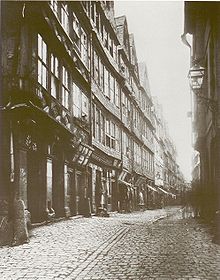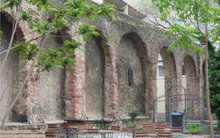Frankfurter Judengasse: Difference between revisions
m removed double entered section |
Started Destruction of Jewish Community 1349 |
||
| Line 21: | Line 21: | ||
===The ''Judenschlacht'' of 1241=== |
===The ''Judenschlacht'' of 1241=== |
||
In [[May]] [[1241]] a [[pogrom]] exploded in Frankfurt, brought on by conflicts over Jewish-[[Christian]] [[Marriage|marriages]] and the resulting obligation for [[baptism]]. The [[Erfurt]] [[Dominican Order|Dominician Friars]] recorded that a few christians and 180 jews died during the pogrom. It also records that 24 jews avoided death by accepting baptism, while under the protection of the city fathers. During the attacks, the synagogue was plundered and the [[Torah]] scrolls were destroyed. All of this occured despite the fact that the jews had been protected by the [[Frederick II, Holy Roman Emperor|Holy Roman Emperor, Frederick II]] since [[1236]], and had a royal appointee running much of the city government. |
In [[May]] [[1241]] a [[pogrom]], known as the ''Judenschlacht''(from German ''Battle of the Jews'') exploded in Frankfurt, brought on by conflicts over Jewish-[[Christian]] [[Marriage|marriages]] and the resulting obligation for [[baptism]]. The [[Erfurt]] [[Dominican Order|Dominician Friars]] recorded that a few christians and 180 jews died during the pogrom. It also records that 24 jews avoided death by accepting baptism, while under the protection of the city fathers. During the attacks, the synagogue was plundered and the [[Torah]] scrolls were destroyed. All of this occured despite the fact that the jews had been protected by the [[Frederick II, Holy Roman Emperor|Holy Roman Emperor, Frederick II]] since [[1236]], and had a royal appointee running much of the city government. |
||
It appears possible that the ''Judenschlacht'' was actually an organized attack instead of a spontaneous massacre. One reason presented is that the fighting lasted several days. Secondly, a strongly fortified tower which contained 70 jewish refugees was captured. Finally, a jewish [[dirge]] records that [[archer|archers]] attacked a Rabbi and his students in their school. All three events imply a measure of planning and the presence of soldiers or a strong militia. |
|||
Exactly who may have been responsible for the ''Judenschlacht'' is unclear due to the lack of sources. The theory that it was lead by the Dominician Friars, who had a [[pope|papal]] order to fight [[heretic|heresy]] is questionable. Another theory is that the pogrom was actually an attack against the [[House of Hohenstaufen|Staufer]] royal family, led by Frederick II. It is unlikely that the actual cause will ever be fully known. |
|||
Frederick II ordered an investigation into the ''Judenschlacht'' that dragged on for years. In [[1246]] [[Conrad IV of Germany|Conrad IV]], on behalf of his father Frederick II, issued a document pardoning the citizens of Frankfurt. It declared a pardon without payment on damages because the pogrom occured, "from carelessness rather than deliberation". The general pardon is an example of the weak political power of the Staufer dynasty in Frankfurt. |
|||
===The Destruction of the Jewish Community 1349=== |
|||
By the 14th Century, Frankfurt was granted the status of a [[Free Imperial City]] by the Emperor [[Louis IV, Holy Roman Emperor|Ludwig the Bavarian]] and [[Charles IV, Holy Roman Emperor|Charles IV]]. As a Free Imperial City, Frankfurt was only responsible to the Holy Roman Emperor and not to local princes. The city operated as a virtual [[City-state]] with limited control from the Emperor. This new wealth and freedom led to the total domination of city government by a few wealthly elites. |
|||
The ''Judenschlacht'' lasted several days and involved the capture of a strongly fortified tower, both of which imply the participation of professional soldiers in the pogrom. |
|||
==References== |
==References== |
||
Revision as of 22:52, 3 July 2007
50°6′49″N 8°41′13″E / 50.11361°N 8.68694°E


The Frankfurter Judengasse (from German: “Jews' Lane”) was the Jewish ghetto of Frankfurt and the earliest of its kind in Germany. It existed from 1462 until 1796 and was home to Germany's largest Jewish community in early modern times .
At the end of the 19th century, most of the buildings in the Judengasse were torn down. The area suffered major destruction during Second World War and reconstruction left no visible signs of the ghetto in today's street map of Frankfurt.
Post-war usage of the area included a car park, a petrol station and a wholesale flower market. The decision to build an administrative complex triggered a public discussion as to what should be done with the archaeological remains uncovered during the construction work in 1977. 19 foundations were found and five of them can be seen at "Museum Judengasse" which was incorporated into the new building. [1]
Location

The ghetto was located outside the city walls east of the medieval city wall (Staufenmauer) and formed a slight curve from today's Konstablerwache to Börneplatz, near the Main river. The street was about 330 meters long, three to four meters wide, and had three town gates. The gates were locked at night as well as on Sundays and Christian holidays. Due to the narrow street and limited access, the Judengasse was destroyed 3 times in just the 18th Century, in 1711, 1721 and 1796.
Initially, some 15 families with about 110 members lived in Frankfurt's Judengasse when they were forcibly removed from the city and relocated to the ghetto by decree of Frederick III in 1462. In the 16th century, the number of inhabitants rose to over 3,000, living in 195 houses.[2]. The ghetto had one of the highest population densities in Europe. Contemporary accounts describe the ghetto as a narrow, oppressive and dirty city section.
History before the Creation of the Ghetto
It is likely that some of the earliest inhabitants of Frankfurt were Jewish. On January 18 1074 Heinrich IV granted the citizens and Jews of Worms and other locations, including Frankfurt, certain privileges relating to reductions in fees and import duties. Eighty years later the Mainz based Rabbi Elieser ben Nathan (died between 1145 and 1152) mentioned the jewish community in Frankfurt is his book Eben ha Eser. Most likely the community was still very small at this point.
Until the Late Middle Ages, the Frankfurt Jews lived in the present-day old city, between the Saint Bartholomeus' Cathedral, Fahrgasse and the Main River. This fine section of the city was also the center of political life in Frankfurt. The town hall, mint and a mansion of the Archbishop of Mainz. During this time the Frankfurt Jews were allowed to travel throughout the city, which was an unusual freedom in the Holy Roman Empire. Additionally, there were many non-jews who lived in the Jewish section of town.
The Judenschlacht of 1241
In May 1241 a pogrom, known as the Judenschlacht(from German Battle of the Jews) exploded in Frankfurt, brought on by conflicts over Jewish-Christian marriages and the resulting obligation for baptism. The Erfurt Dominician Friars recorded that a few christians and 180 jews died during the pogrom. It also records that 24 jews avoided death by accepting baptism, while under the protection of the city fathers. During the attacks, the synagogue was plundered and the Torah scrolls were destroyed. All of this occured despite the fact that the jews had been protected by the Holy Roman Emperor, Frederick II since 1236, and had a royal appointee running much of the city government.
It appears possible that the Judenschlacht was actually an organized attack instead of a spontaneous massacre. One reason presented is that the fighting lasted several days. Secondly, a strongly fortified tower which contained 70 jewish refugees was captured. Finally, a jewish dirge records that archers attacked a Rabbi and his students in their school. All three events imply a measure of planning and the presence of soldiers or a strong militia.
Exactly who may have been responsible for the Judenschlacht is unclear due to the lack of sources. The theory that it was lead by the Dominician Friars, who had a papal order to fight heresy is questionable. Another theory is that the pogrom was actually an attack against the Staufer royal family, led by Frederick II. It is unlikely that the actual cause will ever be fully known.
Frederick II ordered an investigation into the Judenschlacht that dragged on for years. In 1246 Conrad IV, on behalf of his father Frederick II, issued a document pardoning the citizens of Frankfurt. It declared a pardon without payment on damages because the pogrom occured, "from carelessness rather than deliberation". The general pardon is an example of the weak political power of the Staufer dynasty in Frankfurt.
The Destruction of the Jewish Community 1349
By the 14th Century, Frankfurt was granted the status of a Free Imperial City by the Emperor Ludwig the Bavarian and Charles IV. As a Free Imperial City, Frankfurt was only responsible to the Holy Roman Emperor and not to local princes. The city operated as a virtual City-state with limited control from the Emperor. This new wealth and freedom led to the total domination of city government by a few wealthly elites.
References
External links
